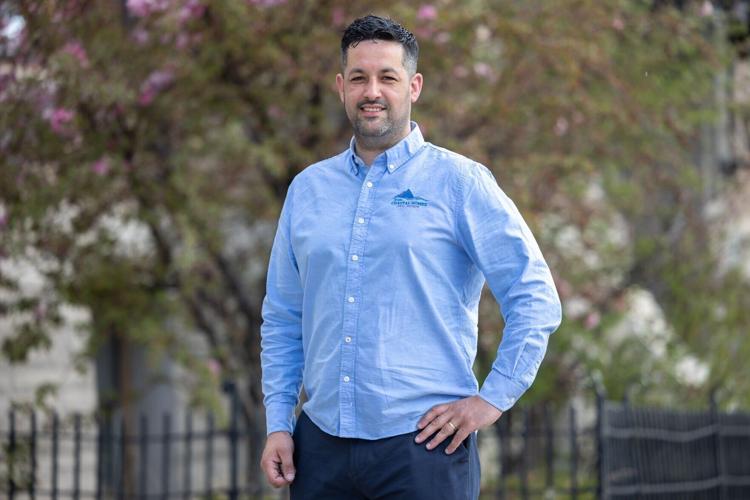“Butte is a place we talk about like it belongs to us — and it does. Butte’s past is our past, its people are our people. We have a shared DNA and a shared family history.” — Wayne O Sullivan Shandon
Visiting Butte has long been a dream for Wayne O Sullivan Shandon, who lives in the village of Eyeries in Ireland’s Beara Peninsula.
His dream became a reality this week.

Wayne O Sullivan Shandon stands outside of the Butte-Silver Bow Courthouse during a ceremony welcoming a delegation from Ireland on Wednesday May 21, 2025.
Although it’s his first visit, the Irishman, who travels with more than 50 others from the Beara, is no stranger to this Montana mining town. He has known of its existence since childhood.
“I have always wanted to visit Butte. It’s always been an ambition of mine,” said O Sullivan Shandon. “I’ve been to 15 states now on the East Coast but I’ve never looked forward to a trip as much as this one.”
O Sullivan Shandon said Butte is viewed as the “other parish” of the Beara Peninsula because the Beara is where so many of Butte’s immigrants were born.
“Butte is a huge part of our identity as a Beara person,” he said. “We talked about it in our homes growing up.”
By 1900, an estimated 2,000 people from Beara had already emigrated to Butte. Among that vast number were some of his ancestors, all of whom he intends to honor while in Butte.
One of the main reasons for the large influx coming to Butte at the turn of the last century was because one village, Allihies — was once home to the copper mines of Caminches, Coom, Dooneen, Kealogue and Mountain.
The Beara mines were where the Allihies miners refined their skills and when those mining jobs dwindled, Butte, with its numerous underground mines, was a beacon for many looking for jobs.
Being Irish was an additional bonus. Since Butte’s Copper King Marcus Daly was a native-born Irishman from County Cavan, these newcomers to Butte were practically assured of jobs.
Among those immigrants were many carrying the Sullivan surname, which, since around 1905, remains a predominant last name in Butte. A perfect example can be found in the 1910 Butte City Directory, where 11 pages of Sullivans are listed.

During his visit to Butte this week, Wayne O Sullivan Shandon took a walking tour of the Butte Hill. Here he is standing outside the Original Mine, which is located directly across the street from the old St. Mary's Church on North Main Street.
“I have no doubt my family have contributed to that being the case,” O Sullivan Shandon said.
While mining was one of the ties that bound Butte and Beara, working underground was not the only job in town. As their numbers grew, many would choose to work above ground and become saloonkeepers, housekeepers, policemen, firemen, boarding house proprietors, clerks and newspaper editors.
Some would also hold political positions.
O Sullivan Shandon’s great-great-grandfather, Dennis O Sullivan, had 12 children. Eight of his children, Jack, Tade, Mary, Geoffrey, Jeremiah, Michael, Julia and Nora journeyed to Butte.
O Sullivan Shandon said the above-mentioned are not just names on paper, they are his ancestors.
“Some of them had families and those descendants are my family,” he said.
Tade and Mary returned to their homeland. The other six siblings remained in Butte.
“There was nothing for people to return to, as there were no job opportunities for them, and the home farm was a small holding and was only barely viable when it was farmed by one person,” said O Sullivan Shandon.

David Dudley gestures to a table that was gifted to Butte-Silver Bow, made both from wood from the Irish Beara Peninsula and from Butte, during a ceremony welcoming a delegation from Ireland on Wednesday May 21, 2025 at the Butte-Silver Bow Courthouse.
Several factors drove so many from Beara to Butte besides the fact that mining in the area had pretty much come to a standstill.
O Sullivan Shandon said when his ancestors left Eyeries in the early 1900s, times were very difficult.
“There were decades-long effects from the famine, land ownership rights and disputes with the Crown, sheer poverty, cyclical illness and social turmoil brought on by hundreds of years of British dominance over the Irish people,” he said.
His ancestors’ lives in Butte have generated a multitude of questions, including how their lives were influenced by the available work in Butte, what hardships they experienced, what their lives were like, and just how difficult it was to leave their homeland and more importantly their families.
So far, his visit has lived up to his expectations and has given him some insight.
“Tracing my ancestors has given me a sense of contentment,” he said.
In the past few days, he has patronized one of Butte’s popular Irish pubs, Maloney’s Bar and toured some of the mines on the Butte Hill. He also went to St. Patrick’s Cemetery and has spent more than a few hours at the Butte-Silver Bow Archives researching for more information on his ancestors.

Jim Keane leads a tour group visiting from Ireland into a structure known as the dry building, with lockers and a steam room for miners among other things, on the grounds of the Anselmo Mine on Wednesday May 21, 2025, in Butte.
A trek was made to Clear Grit Terrace and North Main Street, where his ancestors once lived. The houses are now gone and the Catholic church they attended no longer exists, but that didn’t bother O Sullivan Shandon. The fact his ancestors once lived in the area just below Centerville was enough for him.
“Even though there was no longer any tangible evidence, I followed their footsteps and it made me so proud,” he said. “Eyeries was in their hearts wherever they roamed. They were brilliant, brave, resourceful people, and I’m very proud to call them my ancestors.”
Emotions ran high when O Sullivan Shandon and his fellow travelers were able to pay their respects at the Granite Mountain-Speculator Memorial.
“It was quite impressive,” he said.
He found the story of “Big Con” O’Neill, a native of the Beara Peninsula and one of the 166 men killed in the hard-rock mining disaster of June 8, 1917, particularly moving. Not wearing a protective mask, the foreman at the Bell-Diamond attempted to rescue his fellow miners but was rendered unconscious from the gas fumes and died.
Days before the monument visit, O Sullivan Shandon learned from old Butte city directories that in 1906, O’Neill, a foreman at the Bell-Diamond, resided at 25 E. Clear Grit Terrace with his wife and family. Years later, it was home to Julia, his great-great aunt.
It’s because of that history he balks when someone refers to the relationship between Beara and Butte as a connection. Instead, he views it as a bond.

A delegation of Irish visitors gather around the Robert Emmet Literary Association monument in St. Patrick's Cemetery on Wednesday May 21, 2025 in Butte.
“A connection is a thing that is associated or linked to someone or something,” said O Sullivan Shandon. “A bond is a relationship between two people or two groups of people.”
That bond, according to him, remains firmly cemented because of the men, women and children who came from the Beara Peninsula and thankfully, has been passed down through the generations.
O Sullivan Shandon hopes the bond between Beara and Butte will remain strong and continue to grow.
“This trip has been impressive and emotional,” he said. “I will walk away from Butte with a huge sense of pride.”











(0) comments
Welcome to the discussion.
Log In
Keep it Clean. Please avoid obscene, vulgar, lewd, racist or sexually-oriented language.
PLEASE TURN OFF YOUR CAPS LOCK.
Don't Threaten. Threats of harming another person will not be tolerated.
Be Truthful. Don't knowingly lie about anyone or anything.
Be Nice. No racism, sexism or any sort of -ism that is degrading to another person.
Be Proactive. Use the 'Report' link on each comment to let us know of abusive posts.
Share with Us. We'd love to hear eyewitness accounts, the history behind an article.